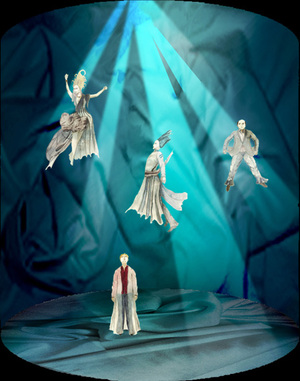The Sea

When the audience member makes it to the other end of the hall, they enter what appears to be an empty room. It is moist and there is the low rumbling of the deep ocean in the background. Theatrical haze fills the room, carving out a single beam of light creating a circle on the fabric-covered floor in the center of the cylindrical space. The ocean-colored fabric covering every surface moves gently. The audience may look around the space while everyone gathers, although it is very dark except where the light is shining.
After all of the audience has arrived, Thornton Wilder’s And the Sea Shall Give Up Its Dead begins. The single shaft of light becomes a shifting, moving beam. It first illuminates Empress Gertruda. She has been in place, slightly raised above the audience, the entire time. The beam of light continues to move slowly and rhythmically, sometimes bringing her into view, other times hiding the Empress in shadow. Horatio Nissem, who has also already been in place, is illuminated at his first cue by other moving lights that turn on throughout the piece. The fifth and final light illuminates Father Cosroe in his turn.
There is no question that the five moving beams of light come from above. However, there is a question of their source. The setting is post-apocalyptic, so the sun is not necessarily the only or even one of the sources of light. There may be many stars. Perhaps the light doesn’t even come from heavenly bodies. The colors are highly saturated blues and greens.
Throughout the piece, the actors are slowly being lifted by body harnesses on vertical tracks moving up the walls, higher and higher above the audience within the space. As they become more frantic toward the end, they rise almost to the top of the cylinder and the rumbling of the ocean turns to a roar. A blinding light causes the audience below to recoil. After the flash, there is silence. The actors have disappeared and the light is red and orange, setting fire to the ocean. Then it fades to black.
After all of the audience has arrived, Thornton Wilder’s And the Sea Shall Give Up Its Dead begins. The single shaft of light becomes a shifting, moving beam. It first illuminates Empress Gertruda. She has been in place, slightly raised above the audience, the entire time. The beam of light continues to move slowly and rhythmically, sometimes bringing her into view, other times hiding the Empress in shadow. Horatio Nissem, who has also already been in place, is illuminated at his first cue by other moving lights that turn on throughout the piece. The fifth and final light illuminates Father Cosroe in his turn.
There is no question that the five moving beams of light come from above. However, there is a question of their source. The setting is post-apocalyptic, so the sun is not necessarily the only or even one of the sources of light. There may be many stars. Perhaps the light doesn’t even come from heavenly bodies. The colors are highly saturated blues and greens.
Throughout the piece, the actors are slowly being lifted by body harnesses on vertical tracks moving up the walls, higher and higher above the audience within the space. As they become more frantic toward the end, they rise almost to the top of the cylinder and the rumbling of the ocean turns to a roar. A blinding light causes the audience below to recoil. After the flash, there is silence. The actors have disappeared and the light is red and orange, setting fire to the ocean. Then it fades to black.
